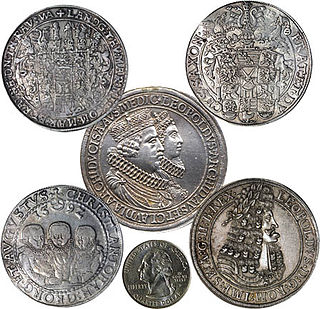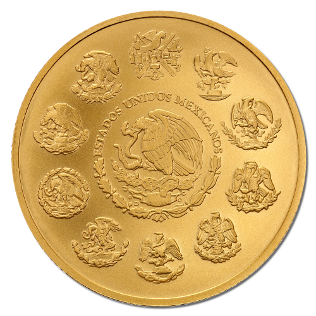
A thaler or taler is one of the large silver coins minted in the states and territories of the Holy Roman Empire and the Habsburg monarchy during the Early Modern period. A thaler size silver coin has a diameter of about 40 mm and a weight of about 25 to 30 grams. The word is shortened from Joachimsthaler, the original thaler coin minted in Joachimsthal, Bohemia, from 1520.
The Mexican peso is the official currency of Mexico. The peso was first introduced in 1863, replacing the old Spanish colonial real. The Mexican peso is subdivided into 100 centavos, represented by "¢". Mexican banknotes are issued by the Bank of Mexico in various denominations and feature vibrant colors and imagery representing Mexican culture and history. Modern peso and dollar currencies have a common origin in the 16th–19th century Spanish dollar, most continuing to use its sign, "$".

The peso is the monetary unit of several Spanish-speaking countries in Latin America, as well as the Philippines. Originating in the Spanish Empire, the word peso translates to "weight". In most countries of the Americas, the symbol commonly known as dollar sign, "$", was originally used as an abbreviation of "pesos" and later adopted by the dollar. The dollar itself actually originated from the peso or Spanish dollar in the late 18th century. The sign "₱" is used in the Philippines.

The crown was a denomination of sterling coinage worth a quarter of one pound. The crown was first issued during the reign of Edward VI, as part of the coinage of the Kingdom of England.

The Royal Canadian Mint is the mint of Canada and a Crown corporation, operating under an act of parliament referred to as the Royal Canadian Mint Act. The shares of the mint are held in trust for the Crown in right of Canada.

The dollar coin is a United States coin with a face value of one United States dollar. Dollar coins have been minted in the United States in gold, silver, and base metal versions. Dollar coins were first minted in the United States in 1794.

Philippine peso coins are issued by the Bangko Sentral ng Pilipinas for circulation in the Philippines and are currently available in seven denominations. The Philippine peso has been in use since Spanish rule.

The Morgan dollar is a United States dollar coin minted from 1878 to 1904, in 1921, and beginning again in 2021 as a collectible. It was the first standard silver dollar minted since the passage of the Coinage Act of 1873, which ended the free coining of silver and the production of the previous design, the Seated Liberty dollar. It contained 412.5 Troy grains of 90% pure silver. The coin is named after its designer, United States Mint Assistant Engraver George T. Morgan. The obverse depicts a profile portrait representing Liberty, modeled by Anna Willess Williams, while the reverse depicts an eagle with wings outstretched. The mint mark, if present, appears on the reverse above between D and O in "Dollar".

The Britannia is a bullion coin issued by the Royal Mint. It has been minted in gold since 1987, in silver since 1997, and in platinum since 2018. The reverse of the coin patterns feature various depictions of Britannia, a feminine personification of the United Kingdom, while the obverse features the effigy of the monarch of the United Kingdom with the legend around it.
The Canadian Gold Maple Leaf (GML) is a gold bullion coin that is issued annually by the Government of Canada. It is produced by the Royal Canadian Mint.

Vreneli is the informal name for a range of legal tender gold coins of the Swiss franc. The coins were issued between 1897 and 1936, in 1947 and in 1949. All coins issued after 1936 are restrikes.

The Chinese Silver Panda is a series of silver bullion coins issued by the People's Republic of China. The design of the panda is changed every year and minted in different sizes and denominations, ranging from 0.5 troy oz. to 1 kilogram. Starting in 2016, Pandas switched to metric sizes. The 1 troy ounce coin was reduced to 30 grams, while the 5 troy ounce coin was reduced to 150 grams. There is also a Gold Panda series issued featuring the same designs as the Silver Panda coins.

The real was the currency of the Federal Republic of Central America from the passing of the coinage law of 19 March 1824 to the dissolution of the republic in 1838. Sixteen silver reales equaled one gold escudo, and a coin of eight reales was called a peso. The Central American Republic's real replaced the Spanish colonial real at par and continued to circulate and be issued after the constituent states left the Central American Republic. Federation coins were minted in Guatemala, Costa Rica, and Honduras, while additional provisional issues were minted at various points in Costa Rica, Honduras, and El Salvador. Both Guatemala and Costa Rica continued minting coins in the style of the republican real until the late 1840s; the currency was eventually replaced by the Costa Rican real, Salvadoran peso, Guatemalan peso, Honduran real and Nicaraguan peso.
The coins of Canada are produced by the Royal Canadian Mint and denominated in Canadian dollars ($) and the subunit of dollars, cents (¢). An effigy of the reigning monarch always appears on the obverse of all coins. There are standard images which appear on the reverse, but there are also commemorative and numismatic issues with different images on the reverse.

This article provides an outline of the currency of Spanish America from Spanish colonization in the 15th century until Spanish American independencies in the 19th. This great realm was divided into the Viceroyalty of New Spain, which came to include all Spanish territory north of Panama, the West Indies, Venezuela, and the Philippines, and the Viceroyalty of Peru, which included Panama and all Spanish territory in South America except Venezuela. The monetary system of Spanish America, originally identical to that of Spain, soon diverged and took on a distinctive character of its own, which it passed on to the independent nations that followed after.

The United States dollar is the official currency of the United States and several other countries. The Coinage Act of 1792 introduced the U.S. dollar at par with the Spanish silver dollar, divided it into 100 cents, and authorized the minting of coins denominated in dollars and cents. U.S. banknotes are issued in the form of Federal Reserve Notes, popularly called greenbacks due to their predominantly green color.

The Libertad coins are silver and gold bullion coins originating from Mexico and minted by the Casa de Moneda de México. The Mexican Mint was established in 1535 and is the oldest mint in the Americas. The modern coins contain 99.9% silver or gold and are available in various sizes. Both metal coins have undergone a design change. In 1989, 3,500 1⁄4 ounce Libertad platinum coins were produced. Libertads are devoid of face value, yet are legal tender, still accepted as currency and guaranteed by Banco de México, based on the market value of its gold or silver content.

A shooting thaler is a silver coin in thaler size minted to commemorate a Schützenfest or free shooting in Switzerland.

The "Pahlavi Coins" were the official gold coins of Iran from 1926 to 1979, and the term "Pahlavi" is the currency of these coins. These coins replaced the Qajar Toman gold coins when Reza Shah Pahlavi came to power in 1925 and the monetary system changed in 1926. In 1979 and coincidence with Revolution in Iran the name of these coins changed to "Bahar Azadi" coins.

Manx Angels are gold or silver bullion coins distributed by the Isle of Man and minted by private companies. The Isle of Man is not part of the United Kingdom. It is a Crown dependency and thus can mint its own coins. The coin depicts Archangel Michael slaying a dragon. The silver coins have not been minted every year, but have an erratic schedule. Angels are legal tender but they do not have a fixed face value; instead, like the Krugerrand or Mexico's Libertad, they are legal tender to the value of their precious metal content.

















